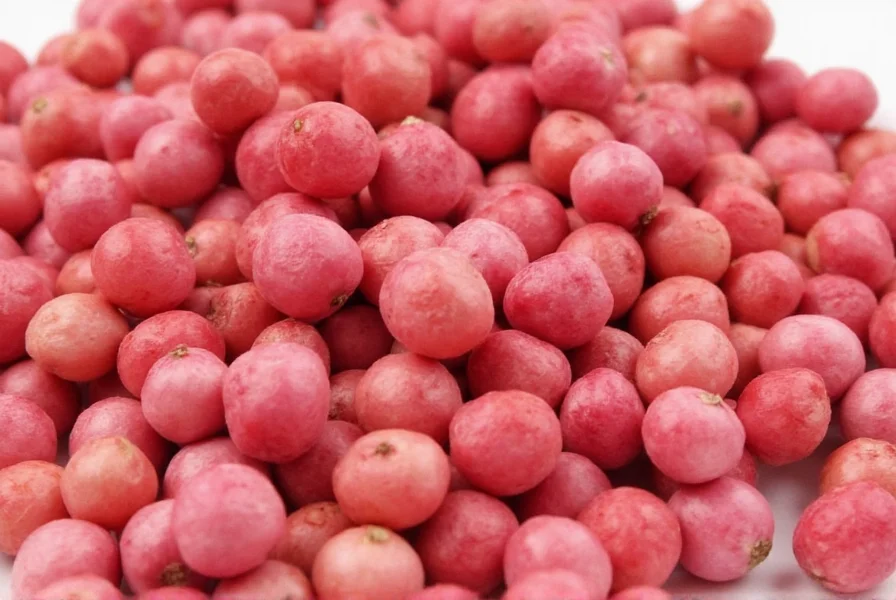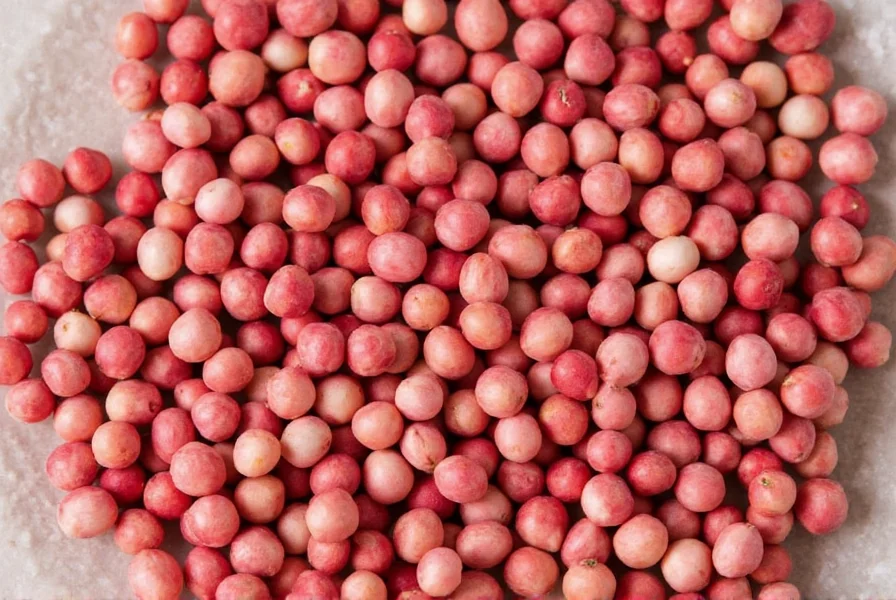Pink peppercorns are not true peppercorns but dried berries from the Schinus molle tree. They are safe for human consumption but toxic to dogs. This guide covers their safety, health benefits, culinary uses, sourcing, and storage—everything you need to know as a home cook or chef.
Key Facts at a Glance
- Safety: Safe for humans when consumed in moderation; toxic to dogs
- Origin: South American Schinus molle tree (not Piper nigrum)
- Flavor: Sweet, citrusy, floral with subtle heat (not spicy like black pepper)
- Best Uses: Finishing spice for desserts, seafood, cocktails, and dressings
- Health Benefits: Rich in antioxidants; anti-inflammatory properties
- Storage: Keep in airtight container away from light; lasts up to 2 years
What Are Pink Peppercorns?
Despite their name, pink peppercorns are not related to black, white, or green peppercorns. They come from the Schinus molle (Peruvian pepper tree) or Schinus terebinthifolius (Brazilian pepper tree) berries. Commercially available pink peppercorns are sourced from Reunion Island or Madagascar under strict agricultural standards to ensure safety and quality.
Safety and Health Considerations
Are pink peppercorns safe to eat? Yes, when sourced from reputable suppliers. The U.S. FDA approved them for consumption after initial allergen concerns were addressed. However:
- They are toxic to dogs and cats—keep away from pets
- Not recommended for pregnant women due to limited safety studies
- May cause allergic reactions in people sensitive to cashews or mangoes (same botanical family)
Health benefits: Research shows pink peppercorns contain polyphenols with antioxidant and anti-inflammatory properties. A 2020 study in the Journal of Food Science noted their potential to support digestive health and reduce oxidative stress. Always consult a healthcare provider before using them for medicinal purposes.
Flavor Profile and Culinary Uses
Pink peppercorns offer a delicate, complex flavor profile that differs significantly from black pepper:
- Sweetness: Dried stone fruits like cherries and apricots
- Citrus Notes: Lemon zest and lime peel
- Subtle Heat: 1/10th the intensity of black pepper
- Floral Undertones: Rose petals or hibiscus
Best culinary applications:
- Finishing spice: Add after cooking to preserve flavor (heat destroys their delicate notes)
- Seafood: Perfect for scallops, salmon, or shrimp—enhances briny sweetness
- Desserts: Pair with dark chocolate, strawberries, or whipped cream
- Cocktails: Muddle into gin-based drinks for botanical complexity
- Vinegars and oils: Infuse in apple cider vinegar or olive oil for dressings
| Source | Scientific Name | Origin | Flavor Notes |
|---|---|---|---|
| Peruvian Pepper Tree | Schinus molle | South America (Peru, Brazil) | Fruity, sweet, mild heat |
| Brazilian Pepper Tree | Schinus terebinthifolius | Brazil | Stronger, spicier, more resinous |
Buying Guide: How to Choose the Best Pink Peppercorns
| Factor | Description |
|---|---|
| Color | Bright pink to reddish hue—avoid dull or faded berries |
| Size & Shape | Uniform, plump berries with slight sheen |
| Packaging | Airtight containers or vacuum-sealed bags |
| Source | Reunion Island, Madagascar, or organic-certified regions |
| Allergen Info | Check for tree nut processing facilities |
Storage Tips
- Store in airtight containers away from direct sunlight
- Keep in cool, dry places (pantry or spice drawer)
- Whole berries last longer than ground—grind only when needed
- Shelf life: Up to 2 years when stored properly
Frequently Asked Questions
Are pink peppercorns actually peppercorns?
No. Pink peppercorns come from Schinus molle trees, not Piper nigrum (the plant that produces black, white, or green peppercorns). They're dried berries, not true peppercorns.
Can I substitute pink peppercorns for black pepper?
Not directly. Pink peppercorns are milder and sweeter. Use them as a finishing spice where their floral notes shine, not as a direct heat substitute. For recipes requiring black pepper's sharpness, consider using a blend of both.
Why are pink peppercorns more expensive?
They require hand-harvesting to preserve color, have limited growing regions, and undergo delicate processing. Unlike black pepper, they can't be dried with high heat, making production more labor-intensive.
Fun Facts
- Once banned in the U.S. due to allergen concerns—now approved in limited quantities
- In France, they're called "baies roses" and used in quatre épices blends
- Used in perfumery for floral and oriental fragrances
- Pair exceptionally well with goat cheese and blue cheeses












 浙公网安备
33010002000092号
浙公网安备
33010002000092号 浙B2-20120091-4
浙B2-20120091-4